Abstract
The term LASER is an acronym for ‘Light Amplification by the Stimulated Emission of Radiation’. As its first application in dentistry by Miaman, in 1960, the laser has seen various hard and soft tissue applications. In the last two decades, there has been an explosion of research studies in laser application. In hard tissue application, the laser is used for caries prevention, bleaching, restorative removal and curing, cavity preparation, dentinal hypersensitivity, growth modulation and for diagnostic purposes, whereas soft tissue application includes wound healing, removal of hyperplastic tissue to uncovering of impacted or partially erupted tooth, photodynamic therapy for malignancies, photostimulation of herpetic lesion. Use of the laser proved to be an effective tool to increase efficiency, specificity, ease, and cost and comfort of the dental treatment.
Keywords: Dental application, lasers, photostimulation
INTRODUCTION
Introduction of laser in dentistry, in the 1960s, by Miaman,[1] led to a continuous research in the various applications of lasers in dental practice. There are two scenarios, on the one hand there are hard lasers, such as, Carbon dioxide (CO2), Neodymium Yttrium Aluminum Garnet (Nd: YAG), and Er:YAG, which offer both hard tissue and soft tissue applications, but have limitations[2,3] due to high costs and a potential for thermal injury to tooth pulp, whereas, on the other hand in cold or soft lasers, based on the semiconductor diode devices, which are compact, low-cost devices used predominantly for applications, are broadly termed as low-level laser therapy (LLLT) or ‘biostimulation’.[4] On account of the ease, efficiency, specificity, comfort, and cost over the conventional modalities, lasers are indicated for a wide variety[5,6,7,8] of procedures in dental practice. The aim of this review is to focus on the hard as well as soft tissue applications, in dentistry.
HISTORY
In 1917, Albert Einstein[9] laid the foundation for the invention of the laser and its predecessor, ‘the Maser,’ by theorizing that photoelectric amplification could emit a single frequency, or stimulated emission. The term LASER is an acronym for ‘Light Amplification by the Stimulated Emission of Radiation’ and was first introduced to the public in 1959, in an article by a Columbia University graduate student, Gordon Gould.[10] Theodore Maiman, at the Hughes Research Laboratories in Malibu, CA, built the first functioning laser,[1] by using a mixture of helium and neon. In 1961, a laser generated from crystals of yttrium-aluminum-garnet treated with 1-3% neodymium (Nd: YAG) was developed.[10] In 1962, the argon laser was developed, whereas, the ruby laser became the first medical laser to coagulate retinal lesions, when it was used in 1963.[10] In 1964, Patel at Bell Laboratories developed the CO2 laser.[10] Nowadays diode lasers are being extensively used in the field of dentistry.
TYPES OF LASER
Lasers used in dental practice can be classified by various methods: According to the lasing medium used, such as, gas laser and solid laser; according to tissue applicability, hard tissue and soft tissue lasers; according to the range of wavelength [Figure 1], and of course the risk associated with laser application.
Figure 1.
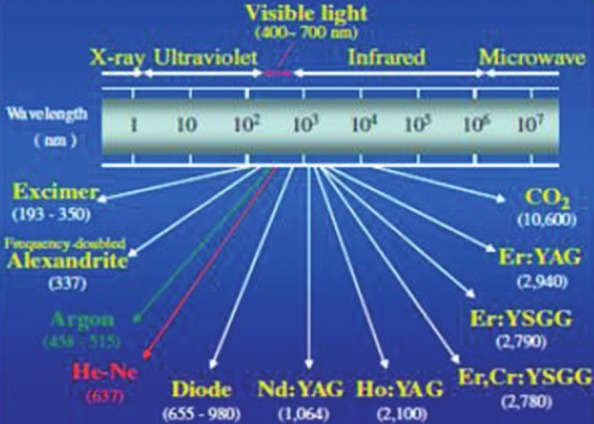
Various types of lasers and their corresponding wavelengths
CARBON DIOXIDE LASER
The CO2 laser wavelength has a very high affinity for water, resulting in rapid soft tissue removal and hemostasis with a very shallow depth of penetration. Although it possesses the highest[11] absorbance of any laser, disadvantages of the CO2 laser are its relative large size and high cost and hard tissue destructive interactions.
NEODYMIUM YTTRIUM ALUMINUM GARNET LASER
The Nd: YAG wavelength is highly absorbed by the pigmented tissue, making it a very effective surgical laser for cutting and coagulating dental soft tissues, with good hemostasis. In addition to its surgical applications,[12] there has been research on using the Nd: YAG laser for nonsurgical sulcular debridement in periodontal disease control[13] and the Laser Assisted New Attachment Procedure (LANAP).[14]
ERBIUM LASER
The erbium ‘family’ of lasers has two distinct wavelengths, Er, Cr: YSGG (yttrium scandium gallium garnet) lasers and Er: YAG (yttrium aluminum garnet) lasers. The erbium wavelengths have a high affinity for hydroxyapatite and the highest absorption of water in any dental laser wavelengths. Consequently, it is the laser of choice for treatment of dental hard tissues.[15] In addition to hard tissue procedures, erbium lasers can also be used for soft tissue ablation, because the dental soft tissue also contains a high percentage of water.[16]
DIODE LASER
The active medium of the diode laser is a solid state semiconductor made of aluminum, gallium, arsenide, and occasionally indium, which produces laser wavelengths, ranging from approximately 810 nm to 980 nm. All diode wavelengths are absorbed primarily by tissue pigment (melanin) and hemoglobin. Conversely, they are poorly absorbed by the hydroxyapatite and water present in the enamel. Specific procedures include aesthetic gingival re-contouring, soft tissue crown lengthening, exposure of soft tissue impacted teeth, removal of inflamed and hypertrophic tissue, frenectomies, and photostimulation of the apthous and herpetic lesions.[17]
MECHANISM OF LASER ACTION
Laser light is a monochromatic light and consists of a single wavelength of light. It consists of three principal parts: An energy source, an active lasing medium, and two or more mirrors that form an optical cavity or resonator. For amplification to occur, energy is supplied to the laser system by a pumping mechanism, such as, a flash-lamp strobe device, an electrical current, or an electrical coil. This energy is pumped into an active medium contained within an optical resonator, producing a spontaneous emission of photons. Subsequently, amplification by stimulated emission takes place as the photons are reflected back and forth through the medium by the highly reflective surfaces of the optical resonator, prior to their exit from the cavity via the output coupler [Figure 2]. In dental lasers, the laser light is delivered from the laser to the target tissue via a fiberoptic cable, hollow waveguide, or articulated arm [Table 1]. Focusing lenses, a cooling system, and other controls complete the system. The wavelength and other properties of the laser are determined primarily by the composition of an active medium, which can be a gas, a crystal, or a solid-state semiconductor.
Figure 2.
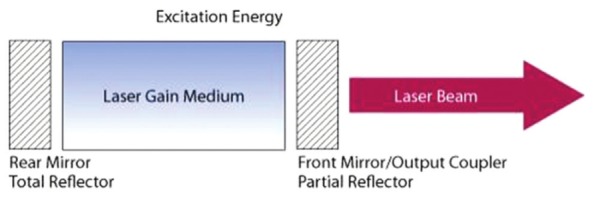
Mechanism of action of the laser
Table 1.
Common laser types used in dentistry
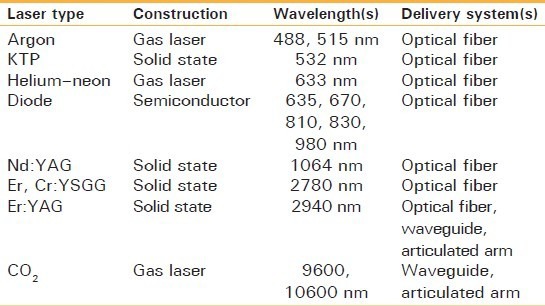
The light energy produced by a laser can have four different interactions with a target tissue:[18,19] Reflection, Transmission, Scattering, and Absorption [Figure 3]. When a laser is absorbed, it elevates the temperature and produces photochemical effects depending on the water content of the tissues. When a temperature of 100°C is reached, vaporization of the water within the tissue occurs, a process called ablation. At temperatures below 100°C, but above approximately 60°C, proteins begin to denature, without vaporization of the underlying tissue. Conversely, at temperatures above 200°C, the tissue is dehydrated and then burned, resulting in an undesirable effect called carbonization.
Figure 3.
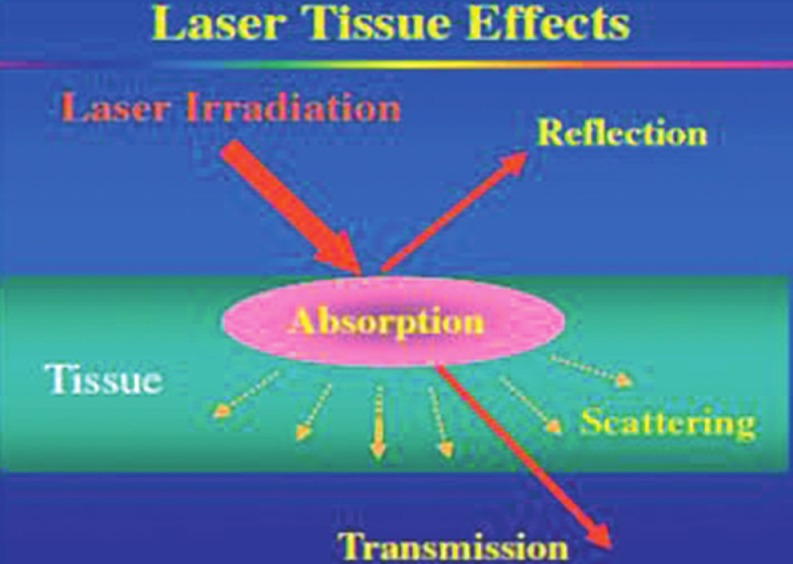
Interactions of the laser on tissue
Absorption requires an absorber of light, termed chromophores, which have a certain affinity for specific wavelengths of light. The primary chromophores in the intraoral soft tissue are Melanin, Hemoglobin, and Water, and in dental hard tissues, Water and Hydroxyapatite. Different laser wavelengths have different absorption coefficients with respect to these primary tissue components, making the laser selection procedure-dependent.[20,21,22]
Depending on application on various tissues, use of laser application in dentistry can be categorized as follows: Soft tissue application and hard tissue application.
SOFT TISSUE APPLICATION
Wound healing
At low doses (e.g., 2 J/cm2), laser application stimulates proliferation, while at high doses (e.g. 16 J/cm2) it is suppressive.[23,24] It affects fibroblast maturation and locomotion,[25] and this in turn may contribute to the higher tensile strengths reported for healed wounds.[26] Low-level laser treatment (LLLT) of gingival fibroblasts in the culture has been shown to induce transformation in myofibroblasts (useful in wound contraction) as early as 24 hours after laser treatment.[27] The positive effects of LLLT on the healing of lesions of recurrent aphthous stomatitis in humans have also been recorded.[28] There are some positive data, which indicate that LLLT promotes healing and dentinogenesis following pulpotomy,[29] as also the healing of mucositis and oropharyngeal ulcerations in patients undergoing radiotherapy for head and neck cancer.[30]
Post herpetic neuralgia and apthous ulcer
It has been demonstrated that photostimulation of aphthous ulcers and recurrent herpetic lesions,[31] with low levels of laser energy (HeNe) can provide pain relief and accelerate healing.[32,33,34,35] In the case of recurrent herpes simplex labialis lesions, photostimulation during the prodromal (tingling) stage seems to arrest the lesions before painful vesicles form, accelerate the overall healing time, and decrease the frequency of recurrence.[36]
Photoactivated dye disinfection using lasers
Low power laser energy is useful for photochemical activation of oxygen-releasing dyes, causing membrane and DNA damage to the microorganisms. The photoactivated dye (PAD) technique can be undertaken with a system using low power (100 milliwatts) visible red semiconductor diode lasers and tolonium chloride (toluidine blue) dye. The PAD technique has been shown to be effective in killing bacteria in complex biofilms, such as, subgingival plaque, which are typically resistant to the action of antimicrobial agents[37,38,39] and can be made species-specific by tagging the dye with monoclonal antibodies.[40] Photoactivated dye can be applied effectively for killing Gram-positive bacteria (including Methicillin-resistant Staphylococcus aureus (MRSA)), Gram-negative bacteria, fungi, and viruses.[41,42] The major clinical applications of PAD include disinfection of root canals, periodontal pockets, deep carious lesions, and sites of peri-implantitis.[43,44] Tolonium chloride is used in high concentrations for screening patients, for malignancies of the oral mucosa and oropharynx.[45,46]
Photodynamic therapy for malignancies
Photodynamic therapy (PDT), which has been employed in the treatment of malignancies of the oral mucosa, particularly multi-focal squamous cell carcinoma, acts on the same principle of PAD, and generates reactive oxygen species, which in turn, directly damages the cells and the associated blood vascular network, triggering both necrosis and apoptosis;[47] this activates the host immune response, and promotes anti-tumor immunity through the activation of macrophages and T lymphocytes.[48] There is direct evidence of the photodynamic activation of production of the tumor necrosis factor, alpha,[49] a key cytokine in host anti-tumor immune responses. Clinical studies have reported positive results for the PDT treatment of carcinoma in-situ and squamous cell carcinoma, in the oral cavity, with response rates approximating 90%.[50,51]
Aesthetic gingival re-contouring and crown lengthening
With the advent of the diode laser, many clinicians are choosing to include optimization of gingival aesthetics as part of the comprehensive orthodontic treatment,[52,53] whereas, conventional gingivectomy [Figure 4] is associated with pain, discomfort, and bleeding.
Figure 4.
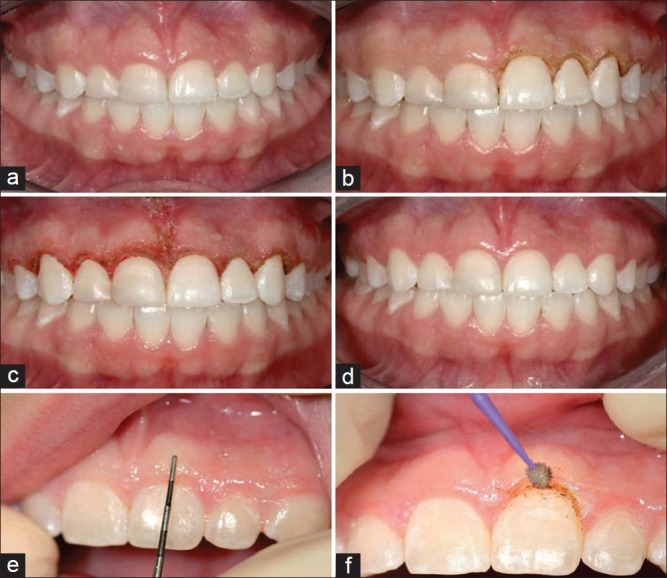
Aesthetic gingival contouring; a-e, pretreatment condition; b-c-f, after laser procedure; d, post treatment
Exposure of unerupted and partially erupted teeth
An impacted or partially erupted tooth can be exposed for bonding by conservative tissue removal, allowing for reasonable positioning of a bracket or button [Figure 5]. It has the advantage of no bleeding, and an attachment can be placed immediately, and moreover, it is not painful at all.
Figure 5.
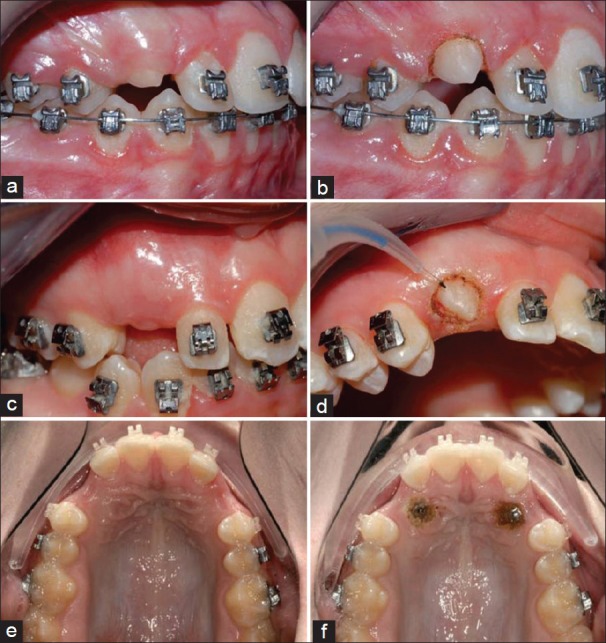
Crown exposure; a-c-e, before exposure; b-d-f, after laser exposure
Removal of inflamed, hypertrophic tissue, and miscellaneous tissue removal
Isolated areas of transient tissue hypertrophy can easily be excised with the diode laser without specialist referral [Figure 6]. The diode laser is also very useful for a number of isolated applications, such as, removing tissue that has overgrown mini-screws, springs [Figure 7a and b], and appliances,[33] as well as for replacing a tissue punch if needed [Figure 7c], when placing mini-screws in the unattached gingiva.
Figure 6.
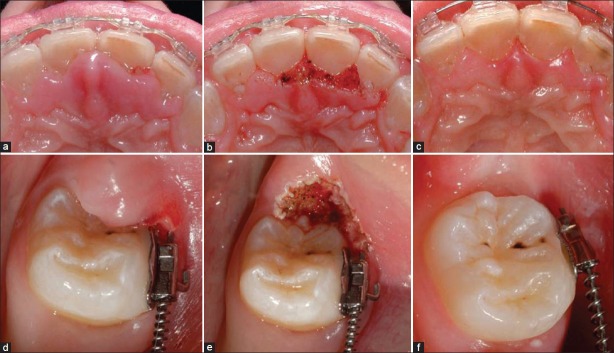
Removal of hyperplastic tissue; a-d, pretreatment; b-e, after laser
Figure 7.
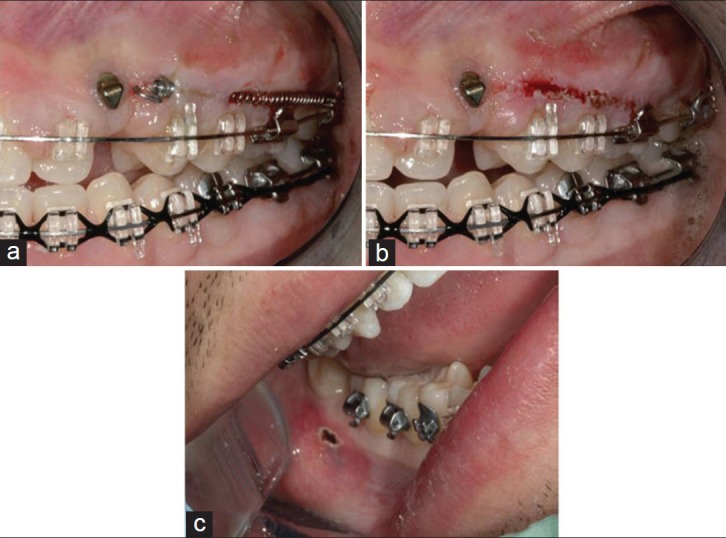
(a and b) Exposure of embedded coil spring used during retraction; (c) a punch hole created for implant placement
Frenectomies
A high or prominent labial frenum [Figure 8a and b], when indicated, laser assisted frenectomy is a simple procedure that is best performed after the diastema is closed as much as possible.[32] Ankylosglossia [Figure 8c and d] can lead to problems with deglutition, speech, malocclusion, and potential periodontal problems. Frenectomies performed with a laser permit excision of the frena painlessly, without bleeding, sutures, or surgical packing, and with no need for special postoperative care.
Figure 8.
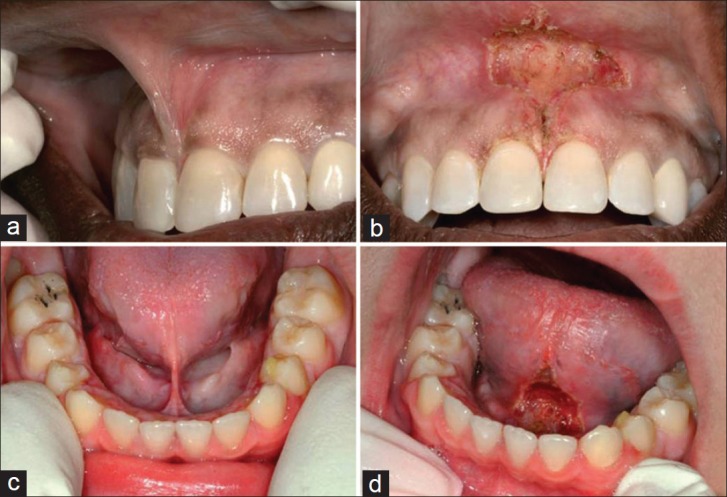
(a and b) labial frenectomy; (c and d) lingual frenectomy
HARD TISSUE APPLICATIONS
Photochemical effects
The argon laser produces high intensity visible blue light (488 nm), which is able to initiate photopolymerization of light-cured dental restorative materials, which use camphoroquinone as the photoinitiator.[54] Argon laser radiation is also able to alter the surface chemistry of both enamel and root surface dentine,[55] which reduces the probability of recurrent caries. The bleaching effect relies on the specific absorption of a narrow spectral range of green light (510-540 nm) into the chelate compounds formed between the apatites, porphyrins, and tetracycline compounds.[56] Argon and Potassium Titanyl Phosphate (KTiOPO4, KTP) lasers can achieve a positive result in cases that are completely unresponsive to conventional photothermal ‘power’ bleaching.
Laser fluorescence
Enamel demineralization with white spot formation on the buccal surfaces of the teeth is a relatively common side effect from orthodontic treatment with fixed appliances.[57,58] There is evidence, however, which suggests that such small areas of superficial enamel demineralization may re-mineralize.[59]
Cavity preparation, caries, and restorative removal
Various studies depict the use of Er: YAG, since 1988, for removing caries in the enamel and dentine by ablation, without the detrimental effect of rise in temperature on the pulp,[60] even without water-cooling,[61] with low ‘fluences’ laser (LLLT), similar to air-rotor devices, except that the floor of the cavity is not as smooth.[62] The Er: YAG laser is capable of removing cement, composite resin, and glass ionomer.[63]
Etching
Laser etching has been evaluated as an alternative to acid etching of enamel and dentine. Enamel and dentine surfaces etched with (Er, Cr: YSGG) lasers show micro-irregularities and no smear layer.[64] Adhesion to dental hard tissues after Er: YAG laser etching is inferior to that obtained after conventional acid etching.[65,66]
Treatment of dentinal hypersensitivity
Dentinal hypersensitivity is one of the most common complaints in clinical dental practice. Comparison of the desensitizing effects of an Er: YAG laser with those of a conventional desensitizing system on cervically exposed hypersensitive dentine[67] showed that desensitizing of hypersensitive dentine with an Er: YAG laser is effective, and maintenance of a positive result is more prolonged than with other agents.
Diagnostic application
The laser is being used for diagnostic purposes [Table 2] in clinical dental practice as well as in research purposes [Table 3].
Table 2.
Diagnostic laser applications in dental practice

Table 3.
Diagnostic laser applications used as research tools in dentistry

3-D Laser scanner for e-model preparation
Our understanding of the growth of craniofacial structures is improving with the development of accurate, low-cost, 3-dimensional (3D) imaging systems, which can be classified as destructive or non-destructive devices,[68] hard or soft tissue imaging devices,[69] and contact or non-contact devices.[70] The laser scanner can be used as a soft tissue scanner and is a valuable tool for its ease of application and creation of 3D images of oral dental structures. There is no need of cast preparation as e-models are prepared from scanned impressions. Images have been created to establish databases for normative populations[71] and cross-sectional growth changes,[72] and also to assess the clinical outcomes in surgical[73,74,75] and non-surgical treatments[76,77] in the head and neck regions.
MISCELLANEOUS APPLICATIONS
Analgesic effect of the laser
In vivo studies of the analgesic effect of LLLT on nerves supplying the oral cavity have shown that LLLT decreases the firing frequency of the nociceptors, with a threshold effect seen in terms of the irradiance required to exert maximal suppression.[78] There have been claims that successful analgesia following oral surgery can be achieved with all major LLLT wavelengths from 632 nm to 904 nm.[79,80] Local CO2 laser irradiation will reduce the pain associated with orthodontic force application, without interfering with tooth movement.[81,82]
Nerve repair and regeneration
Low level laser therapy has been seen to reduce the production of inflammatory mediators of the arachadonic acid family from injured nerves, and to promote neuronal maturation and regeneration following injury.[83,84] The LLLT protocols used, typically involve daily irradiation for prolonged periods, for example, 10 days at 4.5 J per day.[83] The direct application of this technique to dentistry has yielded positive results in promoting the regeneration of inferior dental nerve (IDN) tissue, damaged during surgical procedures.
Post surgical pain
A single episode of LLLT (irradiance 0.9-2.7 J) is 100% effective for apical periodontitis following root canal treatment and post-extraction pain.[85] There are conflicting results with regard to pain reduction post extraction by LLLT verses placebo controls.[86,87,88]
Sinusitis
There are conflicting findings on the benefit for sinusitis by laser therapy. One study[89] denies any significant benefit, while others found that LLLT improved microcirculation, reduced edema, and reduced the frequency of relapses.[90]
Of late, the diode laser has also been tried in experimental animals for controlling the excessive growth of the mandibular condyle. It was found that the laser is effective in regulating facial growth and could be a substitute for the current conventional methods such as a chin-cup.[91] McDonald and Pitt Ford found that the human pulpal blood flow was decreased when continuous light tipping forces were applied to a maxillary canine.[92] Barwick and Ramsay evaluated the effect of a four-minute application of intrusive orthodontic force on human pulpal blood flow with laser-Doppler flowmetry and concluded that the pulpal blood flow was not altered during the application of a brief intrusive orthodontic force.[93]
Recent studies have demonstrated that low-energy laser irradiation stimulates bone formation in vitro and in vivo. The macrophage colony-stimulating factor (M-CSF) is essential and sufficient for osteoclastogenesis. Low-energy laser irradiation stimulates the velocity of tooth movement via the expressions of M-CSF.[94]
Laser safety
While most dental lasers are relatively simple to use, certain precautions should be taken to ensure their safe and effective operation.[95] First and foremost is protective eyewear [Figure 9] by anyone in the vicinity of the laser, while it is in use. This includes the doctor, chairside assistants, patient, and any observers such as family or friends. It is critical that all protective eyewear worn is wavelength-specific. Additionally, accidental exposure to the non-target tissue can be prevented through the use of warning signs posted outside the nominal hazard zone, limiting access to the surgical environment, minimizing the reflective surfaces, and ensuring that the laser is in good working order, with all manufacturer safeguards in place. With regard to prevention of possible exposure to infectious pathogens, high volume suction should be used to evacuate any vapor plume created during tissue ablation, and normal infection protocols should be followed. Each office should have a designated Laser Safety Officer to supervise the proper use of the laser, coordinate staff training, oversee the use of protective eyewear, and be familiar with the pertinent regulations.
Figure 9.
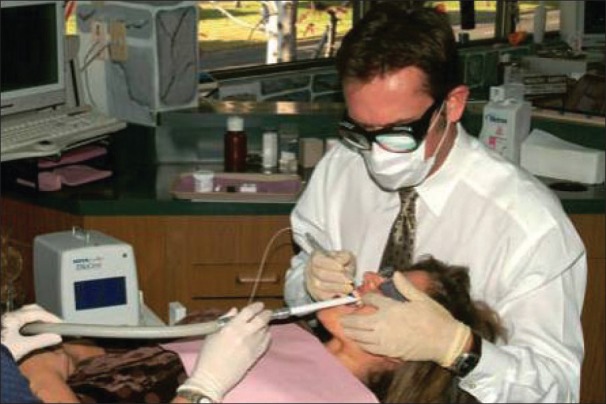
Safety measures in dental office during laser application
Medicolegal considerations
Conservative soft tissue surgery with a dental laser is considered within the scope of accepted dental practice and typically considered a covered procedure under most professional liability insurance policies designed for dental specialists. Informed consent must be routine and is best handled as part of the general consent form that all patients read and sign prior to the initiation of dental treatment. It is highly recommended that each clinician take a course from a reputable provider.
CONCLUSION
Laser technology for hard tissue application and soft tissue surgery is at a high state of refinement, having had several decades of development, up to the present time, and further improvements can occur. The field of laser-based photochemical reactions holds great promise for additional applications, particularly for targeting specific cells, pathogens, or molecules. A further area of future growth is expected to be a combination of diagnostic and therapeutic laser techniques. Looking to the future, it is expected that specific laser technologies will become essential components of contemporary dental practice over the next decade.
Footnotes
Source of Support: Nil
Conflict of Interest: None declared
REFERENCES
- 1.Maiman TH. Stimulated optical radiation in ruby lasers. Nature. 1960;187:493. [Google Scholar]
- 2.Walsh LJ. Dental lasers: Some basic principles. Postgrad Dent. 1994;4:26–9. [Google Scholar]
- 3.Pick RM, Miserendino LJ. Chicago: Quintessence; 1995. Lasers in dentistry; pp. 17–25. [Google Scholar]
- 4.Goldman L, Goldman B, Van-Lieu N. Current laser dentistry. Lasers Surg Med. 1987;6:559–62. doi: 10.1002/lsm.1900060616. [DOI] [PubMed] [Google Scholar]
- 5.Frentzen M, Koort HJ. Lasers in dentistry: New possibilities with advancing laser technology. Int Dent J. 1990;40:323–32. [PubMed] [Google Scholar]
- 6.Aoki A, Ando Y, Watanabe H, Ishikawa I. In vitro studies on laser scaling of sub-gingival calculus with an erbium: YAG laser. J Periodontal. 1994;65:1097–106. doi: 10.1902/jop.1994.65.12.1097. [DOI] [PubMed] [Google Scholar]
- 7.Pelagalli J, Gimbel CB, Hansen RT, Swett A, Winn DW., II Investigational study of the use of Er: YAG Laser versus dental drill for caries removal and cavity preparation – Phase I. J Clin Laser Med Surg. 1997;15:109–15. doi: 10.1089/clm.1997.15.109. [DOI] [PubMed] [Google Scholar]
- 8.Walsh LJ. The current status of laser applications in dentistry. Aust Dent J. 2003;48:146–55. doi: 10.1111/j.1834-7819.2003.tb00025.x. [DOI] [PubMed] [Google Scholar]
- 9.Einstein A. Zur Quantentheorie der Strahlung. Physiol Z. 1917;18:121–8. [Google Scholar]
- 10.Gross AJ, Hermann TR. History of lasers. World J Urol. 2007;25:217–20. doi: 10.1007/s00345-007-0173-8. [DOI] [PubMed] [Google Scholar]
- 11.Fujiyama K, Deguchi T, Murakami T, Fujii A, Kushima K, Takano-Yamamoto T. Clinical effect of CO2 laser in reducing pain in orthodontics. Angle Orthod. 2008;78:299–303. doi: 10.2319/033007-153.1. [DOI] [PubMed] [Google Scholar]
- 12.Fornaini C, Rocca JP, Bertrand MF, Merigo E, Nammour S, Vescovi P. Nd: YAG and diode lasers in the surgical management of soft tissues related to orthodontic treatment. Photomed Laser Surg. 2007;25:381–92. doi: 10.1089/pho.2006.2068. [DOI] [PubMed] [Google Scholar]
- 13.Aoki A, Mizutani K, Takasaki AA, Sasaki KM, Nagai S, Schwarz F, et al. Current status of clinical laser applications in periodontal therapy. Gen Dent. 2008;56:674–87. [PubMed] [Google Scholar]
- 14.Slot DE, Kranendonk AA, Paraskevas S, Van der Weijden F. The effect of a pulsed Nd: YAG laser in non-surgical perdiodontal therapy. J Periodont. 2009;80:1041–56. doi: 10.1902/jop.2009.080571. [DOI] [PubMed] [Google Scholar]
- 15.Harashima T, Kinoshita J, Kimura Y, Brugnera A, Zanin F, Pecora JD, et al. Morphological comparative study on ablation of dental hard tissue at cavity preparation by Er: YAG and Er, CR: YSGG lasers. Photomed Laser Surg. 2005;23:52–5. doi: 10.1089/pho.2005.23.52. [DOI] [PubMed] [Google Scholar]
- 16.Ishikawa I, Aoki A, Takasaki AA. Clinical application of erbium: YAG Laser in periodontology. J Int Acad Periodontol. 2008;10:22–30. [PubMed] [Google Scholar]
- 17.Hilgers JJ, Tracey SG. Clinical uses of diode lasers in orthodontics. J Clin Orthod. 2004;38:266–73. [PubMed] [Google Scholar]
- 18.Carroll L, Humphreys TR. Laser-tissue interactions. Clin Dermatol. 2006;24:2–7. doi: 10.1016/j.clindermatol.2005.10.019. [DOI] [PubMed] [Google Scholar]
- 19.Sulieman M. An overview of the use of lasers in general dentist practice: Laser physics and tissue interactions. (233-4).Dent Update. 2005;32:228–20. doi: 10.12968/denu.2005.32.4.228. 236. [DOI] [PubMed] [Google Scholar]
- 20.Sulieman M. An overview of the use of lasers in general dentist practice, laser wavelengths, soft and hard tissue clinical applications. (291-4).Dent Update. 2005;32:286–8. doi: 10.12968/denu.2005.32.5.286. 296. [DOI] [PubMed] [Google Scholar]
- 21.Tracey SG. Light work. Orthod Products. 2005:88–93. [Google Scholar]
- 22.Weiner GP. Laser dentistry practice management. Dent Clin North Am. 2004;48:1105–26. doi: 10.1016/j.cden.2004.05.001. [DOI] [PubMed] [Google Scholar]
- 23.Tominaga R. Effects of He-Ne laser irradiation on fibroblasts derived from scar tissue of rat palatal mucosa. Kokubyo Gakka Zasshi. 1990;57:580–94. doi: 10.5357/koubyou.57.580. [DOI] [PubMed] [Google Scholar]
- 24.Loevschall H, Arenholtd-Bindslev D. Effect of low level diode laser irradiation of human oral mucosa fibroblasts in vitro. Lasers Surg Med. 1994;14:347–54. doi: 10.1002/lsm.1900140407. [DOI] [PubMed] [Google Scholar]
- 25.Noble PB, Shields ED, Blecher PD, Bentley KC. Locomotory characteristics of fibroblasts within a three-dimensional collagenlattice: Modulation by a helium/neon soft laser. Lasers Surg Med. 1992;12:669–74. doi: 10.1002/lsm.1900120617. [DOI] [PubMed] [Google Scholar]
- 26.Asencio Arana F, Garcia FV, Molina Andreu E, Vidal MJ, Martinez SF. Endoscopic enhancement of the healing of high risk colon anastomoses by low-power helium-neon laser. An experimental study. Dis Colon Rectum. 1992;35:568–73. doi: 10.1007/BF02050537. [DOI] [PubMed] [Google Scholar]
- 27.Pourreau-Schneider N, Ahmed A, Soudry M, Jacquemier J, Kopp F, Franquin JC, et al. Helium-neon laser treatment transforms fibroblasts into myofibroblasts. Am J Pathol. 1990;137:171–8. [PMC free article] [PubMed] [Google Scholar]
- 28.Neiburger EJ. The effect of low-power lasers on intraoral wound healing. NY State Dent J. 1995;61:40–3. [PubMed] [Google Scholar]
- 29.Kurumada F. A study on the application of Ga-As semiconductor laser to endodontics. The effects of laser irradiation on the activation of inflammatory cells and the vital pulpotomy. Ohu Daigaku Shigakushi. 1990;17:233–44. [PubMed] [Google Scholar]
- 30.Kitsmaniuk ZD, Demochko VB, Popovich VI. The use of low energy lasers for preventing and treating postoperative and radiation-induced complications in patients with head and neck tumors. Vopr Onkol. 1992;38:980–6. [PubMed] [Google Scholar]
- 31.Iijima K, Shimoyama N, Shimoyama M, Yamamoto T, Shimizu T, Mizuguchi T. Effect of repeated irradiation of low-power He- Ne laser in pain relief from postherpetic neuralgia. Clin J Pain. 1989;5:271–4. doi: 10.1097/00002508-198909000-00013. [DOI] [PubMed] [Google Scholar]
- 32.Olivi G, Genovese MD, Caprioglio C. Evidence-based dentistry on laser paediatric dentistry. Eur J Paediatr Dent. 2009;10:29–40. [PubMed] [Google Scholar]
- 33.Yeh S, Jain K, Andreana S. Using a diode laser to uncover dental implants in second-stage surgery. Gen Dent. 2005;53:414–7. [PubMed] [Google Scholar]
- 34.Posten W, Wrone DA, Dover JS, Arndt KA, Silapunt S, Alam M. Low-level laser therapy for wound healing: Mechanism and efficacy. Dermatol Surg. 2005;31:334–40. doi: 10.1111/j.1524-4725.2005.31086. [DOI] [PubMed] [Google Scholar]
- 35.Ross G, Ross A. Low level lasers in dentistry. Gen Dent. 2008;56:629–34. [PubMed] [Google Scholar]
- 36.Hargate G. A randomized double-blind study comparing the effect of 1072-nm light against placebo for the treatment of herpes labialis. Clin Exp Dermatol. 2006;31:638–41. doi: 10.1111/j.1365-2230.2006.02191.x. [DOI] [PubMed] [Google Scholar]
- 37.Dobson J, Wilson M. Sensitization of oral bacteria in biofilms to killing by light from a low-power laser. Arch Oral Biol. 1992;37:883–7. doi: 10.1016/0003-9969(92)90058-g. [DOI] [PubMed] [Google Scholar]
- 38.Sarker S, Wilson M. Lethal photosensitization of bacteria in subgingival plaque from patients with chronic periodontitis. J Periodontal Res. 1993;28:204–10. doi: 10.1111/j.1600-0765.1993.tb01070.x. [DOI] [PubMed] [Google Scholar]
- 39.Wilson M. Bacterial effect of laser light and its potential use in the treatment of plaque-related diseases. Int Dent J. 1994;44:181–9. [PubMed] [Google Scholar]
- 40.Bhatti M, MacRobert A, Henderson B, Shepherd P, Cridland J, Wilson M. Antibody-targeted lethal photosensitization of Porphyromonasgingivalis. Antimicrob Agents Chemother. 2000;44:2615–8. doi: 10.1128/aac.44.10.2615-2618.2000. [DOI] [PMC free article] [PubMed] [Google Scholar]
- 41.O’Neill JF, Hope CK, Wilson M. Oral bacteria in multi-species biofilms can be killed by red light in the presence of toluidine blue. Lasers Surg Med. 2002;31:86–90. doi: 10.1002/lsm.10087. [DOI] [PubMed] [Google Scholar]
- 42.Seal GJ, Ng YL, Spratt D, Bhatti M, Gulabivala K. An in vitro comparison of the bactericidal efficacy of lethal photosensitization or sodium hyphochlorite irrigation on Streptococcus intermedius biofilm in root canals. Int Endodont J. 2002;35:268–74. doi: 10.1046/j.1365-2591.2002.00477.x. [DOI] [PubMed] [Google Scholar]
- 43.Walsh LJ. The current status of low level laser therapy in dentistry. Part 2. Hard tissue applications. Aust Dent J. 1997;42:302–6. doi: 10.1111/j.1834-7819.1997.tb00134.x. [DOI] [PubMed] [Google Scholar]
- 44.Dortbudak O, Haas R, Bernhart T, Mailath-Pokorny G. Lethal photosensitization for decontamination of implant surfaces in the treatment of peri-implantitis. Clin Oral Implants Res. 2001;12:104–8. doi: 10.1034/j.1600-0501.2001.012002104.x. [DOI] [PubMed] [Google Scholar]
- 45.Epstein JB, Oakley C, Millner A, Emerton S, van der Meij E, Le N. The utility of toluidine blue application as a diagnostic aid in patients previously treated for upper oropharyngeal carcinoma. Oral Surg Oral Med Oral Pathol Oral Radiol Endod. 1997;83:537–47. doi: 10.1016/s1079-2104(97)90117-7. [DOI] [PubMed] [Google Scholar]
- 46.Feaver GP, Morrison T, Humphris G. A study to determine the acceptability in patients and dentists of toluidine blue in screening for oral cancer. Prim Dent Care. 1999;6:45–50. [PubMed] [Google Scholar]
- 47.Dougherty TJ. An update on photodynamic therapy applications. J Clin Laser Med Surg. 2002;20:3–7. doi: 10.1089/104454702753474931. [DOI] [PubMed] [Google Scholar]
- 48.Walsh LJ. Safety issues relating to the use of hydrogen peroxide in dentistry. Aust Dent J. 2000;45:257–69. doi: 10.1111/j.1834-7819.2000.tb00261.x. [DOI] [PubMed] [Google Scholar]
- 49.Vowels BR, Cassin M, Boufal MH, Walsh LJ, Rook AH. Extracorporeal photophoresis induces the production of tumor necrosis factor-alpha by monocytes: Implications for the treatment of cutaneous T-cell lymphoma and systemic sclerosis. J Invest Dermatol. 1992;98:686–92. doi: 10.1111/1523-1747.ep12499907. [DOI] [PubMed] [Google Scholar]
- 50.Fan KF, Hopper C, Speight PM, Buonaccorsi GA, Bown SG. Photodynamic therapy using mTHPC for malignant disease in the oral cavity. Int J Cancer. 1997;73:25–32. doi: 10.1002/(sici)1097-0215(19970926)73:1<25::aid-ijc5>3.0.co;2-3. [DOI] [PubMed] [Google Scholar]
- 51.Biel MA. Photodynamic therapy and the treatment of head and neck neoplasia. Laryngoscope. 1998;108:1259–68. doi: 10.1097/00005537-199809000-00001. [DOI] [PubMed] [Google Scholar]
- 52.Sarver DM, Yanosky M. Principles of cosmetic dentistry in orthodontics: Part 2. Soft tissue laser technology and cosmetic gingival contouring. Am J Orthod Dentofac Orthop. 2005;127:85–90. doi: 10.1016/j.ajodo.2004.07.035. [DOI] [PubMed] [Google Scholar]
- 53.Sarver DM, Yanosky M. Principles of cosmetic dentistry in orthodontics: Part 3. Laser treatments for tooth eruption and soft tissue problems. Am J Orthod Dentofac Orthop. 2005;127:262–4. doi: 10.1016/j.ajodo.2004.07.036. [DOI] [PubMed] [Google Scholar]
- 54.Fleming MG, Maillet WA. Photopolymerization of composite resin using the argon laser. J Can Dent Assoc. 1999;65:447–50. [PubMed] [Google Scholar]
- 55.Westerman G, Hicks J, Flaitz C. Argon laser curing of fluoride releasing pit and fissure sealant: In vitro caries development. ASDC J Dent Child. 2000;67:385–90. [PubMed] [Google Scholar]
- 56.Lin LC, Pitts DL, Burgess LW. An investigation into the feasibility of photobleaching tetracycline-stained teeth. J Endod. 1988;14:293–9. doi: 10.1016/S0099-2399(88)80029-3. [DOI] [PubMed] [Google Scholar]
- 57.Wisth PJ, Nord A. Caries experience in orthodontically treated individuals. Angle Orthod. 1977;47:59–64. doi: 10.1043/0003-3219(1977)047<0059:CEIOTI>2.0.CO;2. [DOI] [PubMed] [Google Scholar]
- 58.Gorelick L, Geiger A, Gwinnett AJ. Incidence of white spot formation after bonding and banding. Am J Orthod. 1982;81:93–8. doi: 10.1016/0002-9416(82)90032-x. [DOI] [PubMed] [Google Scholar]
- 59.Marcusson A, Norevall L-I, Persson M. White spot reduction when using glass ionomer cement for bonding in orthodontics: A longitudinal and comparative study. Eur J Orthod. 1997;19:233–42. doi: 10.1093/ejo/19.3.233. [DOI] [PubMed] [Google Scholar]
- 60.Armengol V, Jean A, Marion D. Temperature rise during Er: YAG and Nd: YAP laser ablation of dentine. J Endod. 2000;26:138–41. doi: 10.1097/00004770-200003000-00002. [DOI] [PubMed] [Google Scholar]
- 61.Burkes EJ, Hoke J, Gomes E, Wolbarsht M. Wet versus dry enamel ablation by Er: YAG laser. J Prosthet Dent. 1992;67:847–51. doi: 10.1016/0022-3913(92)90599-6. [DOI] [PubMed] [Google Scholar]
- 62.Cozean C, Arcoria CJ, Pelagalli J, Powell GL. Dentistry for the 21st century? Erbium: YAG laser for teeth. J Am Dent Assoc. 1997;128:1080–7. doi: 10.14219/jada.archive.1997.0364. [DOI] [PubMed] [Google Scholar]
- 63.Dostalova T, Jelinkova H, Kucerova H, Krejsa O, Hamal K, Kubelka J, et al. Noncontact Er: YAG laser ablation: Clinical evaluation. J Clin Laser Med Surg. 1998;16:273–82. [PubMed] [Google Scholar]
- 64.Hossain M, Nakamura Y, Yamada Y, Kimura Y, Matsumoto N, Matsumoto K. Effects of Er, Cr: YSGG laser irradiation in human enamel and dentin: ablation and morphological studies. J Clin Laser Med Surg. 1999;17:155–9. doi: 10.1089/clm.1999.17.155. [DOI] [PubMed] [Google Scholar]
- 65.Martinez-Insua A, Dominguez LS, Rivera FG, Santana-Penin UA. Differences in bonding to acid-etched or Er: YAG–laser–treated enamel and dentine surfaces. J Prosthet Dent. 2000;84:280–8. doi: 10.1067/mpr.2000.108600. [DOI] [PubMed] [Google Scholar]
- 66.Ceballos L, Osorio R, Toledano M, Marshall GW. Microleakage of composite restorations after acid or Er: YAG laser cavity treatment. Dent Mater. 2001;17:340–6. doi: 10.1016/s0109-5641(00)00092-0. [DOI] [PubMed] [Google Scholar]
- 67.Schwarz F, Arweiler N, Georg T, Reich E. Desensitising effects of an Er: YAG laser on hypersensitive dentine, a controlled, prospective clinical study. J Clin Periodont. 2002;29:211–5. doi: 10.1034/j.1600-051x.2002.290305.x. [DOI] [PubMed] [Google Scholar]
- 68.Mah J, Hatcher D. Current status and future needs in craniofacial imaging. (179-82).Orthod Craniofac Res. 2003;6(Suppl 1):10–6. doi: 10.1034/j.1600-0544.2003.230.x. [DOI] [PubMed] [Google Scholar]
- 69.Quintero JC, Trosien A, Hatcher D, Kapila S. Craniofacial imaging in orthodontics: Historical perspective, current status, and future developments. Angle Orthod. 1999;69:491–506. doi: 10.1043/0003-3219(1999)069<0491:CIIOHP>2.3.CO;2. [DOI] [PubMed] [Google Scholar]
- 70.Kau CH, Zhurov AI, Bibb R, Hunter L, Richmond S. The investigation of the changing facial appearance of identical twins employing a three-dimensional imaging system. Orthod Craniofac Res. 2005;8:85–90. doi: 10.1111/j.1601-6343.2005.00320.x. [DOI] [PubMed] [Google Scholar]
- 71.Yamada T, Mori Y, Katsuhiro M, Katsuaki M, Tsukamoto Y. Three-dimensional analysis of facial morphology in normal Japanese children as control data for cleft surgery. Cleft Palate Craniofac J. 2002;39:517–26. doi: 10.1597/1545-1569_2002_039_0517_tdaofm_2.0.co_2. [DOI] [PubMed] [Google Scholar]
- 72.Nute SJ, Moss JP. Three-dimensional facial growth studied by optical surface scanning. J Orthod. 2000;27:31–8. doi: 10.1093/ortho/27.1.31. [DOI] [PubMed] [Google Scholar]
- 73.Ayoub AF, Siebert P, Moos KF, Wray D, Urquhart C, Niblett TB. A vision-based three-dimensional capture system for maxillofacial assessment and surgical planning. Br J Oral Maxillofac Surg. 1998;36:353–7. doi: 10.1016/s0266-4356(98)90646-5. [DOI] [PubMed] [Google Scholar]
- 74.Khambay B, Nebel JC, Bowman J, Walker F, Hadley DM, Ayoub A. 3D stereophotogrammetric image superimposition onto 3D CT scan images: The future of orthognathic surgery. A pilot study. Int J Adult Orthod Orthog Surg. 2002;17:331–41. [PubMed] [Google Scholar]
- 75.Marmulla R, Hassfeld S, Luth T, Muhling J. Laser-scan-based navigation in cranio-maxillofacial surgery. J Craniomaxillofac Surg. 2003;31:267–77. doi: 10.1016/s1010-5182(03)00056-8. [DOI] [PubMed] [Google Scholar]
- 76.Moss JP, Ismail SF, Hennessy RJ. Three-dimensional assessment of treatment outcomes on the face. (179-82).Orthod Craniofac Res. 2003;6(Suppl 1):126–31. doi: 10.1034/j.1600-0544.2003.245.x. [DOI] [PubMed] [Google Scholar]
- 77.McDonagh S, Moss JP, Goodwin P, Lee RT. A prospective optical surface scanning and cephalometric assessment of the effect of functional appliances on the soft tissues. Eur J Orthod. 2001;23:115–26. doi: 10.1093/ejo/23.2.115. [DOI] [PubMed] [Google Scholar]
- 78.Mezawa S, Iwata K, Naito K, Kamogawa H. The possible analgesic effect of soft-laser irradiation on heat nociceptors in the cat tongue. Arch Oral Biol. 1988;33:693–4. doi: 10.1016/0003-9969(88)90125-2. [DOI] [PubMed] [Google Scholar]
- 79.Armida MM. Laser therapy and its applications in dentistry. Pract Odontol. 1989;10:9–16. [PubMed] [Google Scholar]
- 80.Peres F, Felino A, Carvalho JF. Analgesic effect of 904-nm laser radiation (IR) in oral surgery. Rev Port Estomatol Cir Maxilofac. 1985;26:205–17. [PubMed] [Google Scholar]
- 81.Harazaki M, Isshiki Y. Soft laser irradiation effects on pain reduction in orthodontic treatment. Bull Tokyo Dent Coll. 1997;38:291–5. [PubMed] [Google Scholar]
- 82.Turhani D, Scheriau M, Kapral D, Benesch T, Jonke E, Bantleon HP. Pain relief by single low-level laser irradiation in orthodontic patients undergoing fixed appliance therapy. Am J Orthod Dentofacial Orthop. 2006;130:371–7. doi: 10.1016/j.ajodo.2005.04.036. [DOI] [PubMed] [Google Scholar]
- 83.Mester AF, Snow JB, Shaman P. Photochemical effects of laser irradiation on neuritic outgrowth of olfactory neuroepithelial explants. Otolaryngol Head Neck Surg. 1991;105:449–56. doi: 10.1177/019459989110500317. [DOI] [PubMed] [Google Scholar]
- 84.Solomon A, Lavie V, Ben-Bassat S, Belkin M, Schwartz M. New surgical approach to overcome the inability of injured mammalian axons to grow within their environment. J Neural Transplant Plast. 1991;2:243–8. doi: 10.1155/NP.1991.243. [DOI] [PMC free article] [PubMed] [Google Scholar]
- 85.Kawakami T, Ibaraki Y, Haraguchi K, Odachi H, Kawamura H, Kubota M, et al. The effectiveness of GaAlAs semiconductor laser treatment to decrease pain after irradiation. Higashi Nippon Shigaku Zasshi. 1989;8:57–62. [PubMed] [Google Scholar]
- 86.Clokie C, Bentley KC, Head TW. The effects of the helium neon laser on postsurgical discomfort: A pilot study. J Can Dent Assoc. 1991;57:584–6. [PubMed] [Google Scholar]
- 87.Fernando S, Hill CM, Walker R. A randomised double blind comparative study of low level laser therapy following surgical extraction of lower third molar teeth. Br J Oral Maxillofac Surg. 1993;31:170–2. doi: 10.1016/0266-4356(93)90118-g. [DOI] [PubMed] [Google Scholar]
- 88.Roynesdal AK, Bjornland T, Barkvoll P, Haanaes HR. The effect of soft-laser application on postoperative pain and swelling. A double-blind, crossover study. Int J Oral Maxillofac Surg. 1993;22:242–5. doi: 10.1016/s0901-5027(05)80646-0. [DOI] [PubMed] [Google Scholar]
- 89.Moustsen PA, Vinter N, Aas Andersen L, Kragstrup J. Laser treatment of sinusitis in general practice assessed by a doubleblind controlled study. Ugeskr Laeger. 1991;153:2232–4. [PubMed] [Google Scholar]
- 90.Kruchinina I, Feniksova LV, Rybalkin SV, Pekli FF. Therapeutic effect of helium-neon laser on microcirculation of nasal mucosa in children with acute and chronic maxillary sinusitis as measured by conjunctival biomicroscopy. Vestn Otorinolaringol. 1991;3:26–30. [PubMed] [Google Scholar]
- 91.Kharsa MA, Kharsa A. Use of laser in controlling the growth of facial structures, –Laser-Orthopedics. Orthod Cyberjournal. [Last accessed on 5th April 2012]. http://orthocj.com/2005/08/laser-controlling-growth-of-facial-structures-laser-orthopedics .
- 92.McDonald F, Pitt Ford TR. Blood flow changes in permanent maxillary canines during retraction. Eur J Orthod. 1994;16:1–9. doi: 10.1093/ejo/16.1.1. [DOI] [PubMed] [Google Scholar]
- 93.Barwick PJ, Ramsay DS. Effect of brief intrusive force blood flow on human pulpal blood flow. Am J Orthod Dentofacial Orthop. 1996;110:273–9. doi: 10.1016/s0889-5406(96)80011-4. [DOI] [PubMed] [Google Scholar]
- 94.Yamaguchi M, Fujita S, Yoshida T, Oikawa K, Utsunomiya T, Yamamoto H, et al. Low-energy laser irradiation stimulates the tooth movement velocity via expression of M-CSF and c-fms. Orthod Waves. 2007;66:139–48. [Google Scholar]
- 95.Parker S. Laser regulation and safety in general dental practice. Br Dent J. 2007;202:523–32. doi: 10.1038/bdj.2007.370. [DOI] [PubMed] [Google Scholar]


